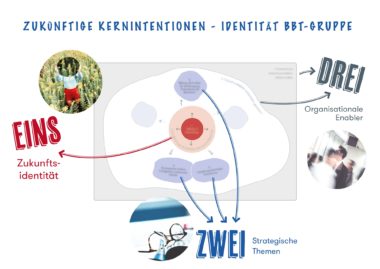Innovation is on everyone’s lips these days. However, the term is used in a rather inflationary way, or without much consideration. Literature on the topic provides various definitions and approaches. In order to clarify the broad concept of innovation and narrow it down to a consistent meaning, we provide a brief overview and summary of the idea of innovation.
A quote by Fariborz Damanpour, professor at Rutgers University, describes innovation in a very broad sense and reflects the most important aspects:
“Innovation is conceived as a process that includes the generation, development, and implementation of new ideas or behaviors. Further, innovation is conceived as a means of changing an organization, either as a response to changes in the external environment or as a preemptive action to influence the environment. Hence innovation is here broadly defined to encompass a range of types, including new products or services, new process technologies, new organizational structures or administrative systems, or new plans or programs pertaining to organizational members.”
(Damanpour, p. 694) [author’s emphases]
What is innovation?
- Innovation is not just a finished product, but a process.
- Innovation has a novelty value.
- It takes more than just a good idea to turn an innovation into an innovation. An innovation only becomes an innovation once it has been successfully implemented in the market.
- Innovation manifests in new behaviors that are valuable for users and meet their needs, or which create latent, novel needs.
- Organizational change is a prerequisite for innovation: sustainable innovation can emerge only if the organization (including its employees) changes from within and opens itself to novelty. This process can also be described as developing organizational “innovation capacities/capabilities”.
- Innovation often is a reaction to changes in the environment or market, an response to (new) competitors; it is often triggered by new technologies or the emergence of (user) needs, etc.
- An advanced form of innovation is to not just react to changes, but to proactively bring about those changes. In other words, innovation is about changing the environment and the market, creating new niches and new user needs.
- Innovation is not limited to (material) products. It also manifests in new services, new processes, new business models and organizational changes.
- Innovation is about creating new spaces for interpretation. Its aim is to create new meanings, new goals and purposes, and to implement them in social systems.
- Innovation strategies
In order to meet the aforementioned requirements for innovation, we can distinguish between various strategies and approaches:
A. Innovation as (linear) extrapolation from the past
This innovation strategy begins with a look at the past. Previous success stories (e.g. successful products, services, strategies, etc.) are being transferred to the future. For example, you could take a successful product as your starting point and change it in one detail. Or you could conduct a brainstorming session or creative workshop, where people usually discuss existing ideas and combine them in new ways. Their brainchild is then projected straight into the future and put into practice. Because the resulting innovations are largely driven by the past, they contain relatively few future perspectives. In some cases, this process does yield radical innovations, but they tend to be too “outside-the-box”, or “too creative”; very often such innovations fail to meet relevant user needs because innovators disregard the market or future challenges.
B. Innovation as learning by trial and error
As with the extrapolation from the past, this innovation process starts with things that already exist. Innovation results from adaptations, which are incrementally developed in a learning process based on a trial-and-error strategy. The resulting innovation is, therefore, relatively conservative. This process and the resulting innovations are also referred to as “incremental innovation”. This approach is commonly applied in the widely used stage-gate innovation strategy.
C. Innovation as learning from the future as it emerges / emergent innovation (leap)
This strategy turns existing approaches upside down. Instead of drawing on the past or the existing, this innovation strategy uses the future as its starting point. To be precise, it uses (future) potentials (for more on this topic, see BP, “Innovation – Potentials vs. Trends”). Innovation is based on in-depth knowledge of the innovation object, its innermost “core”, along with the potential it offers and the ecosystem it is embedded in.
On the basis of this knowledge, an attempt is made to understand and explore what is seeking to “evolve” or “emerge” from the core. This is a process of “learning from the future”, which bears similarity to Otto Scharmer’s presencingapproach. In the context of innovation, Peschl and Fundneider took this process as a starting point to develop their own concept of “emergent innovation” – leap.
leap teaches us that it is not so much our own creativity, but rather the innovation object itself, which reveals potentials that want to emerge. In a way, one engages in a close cooperation with the potential inherent in the innovation object, by creating an “enabling space”, i.e. an environment that favors and enables the emergence of novelty. The resulting innovations originate from the innovation object itself and from its unused potentials – from that, which is “not yet”. This approach enables innovations that are not only radically new but also fit into the existing environment. This “fitness” of innovations relates to mental models, to user needs that are yet to be created, to changes in the market and within organizations.
Innovations brought forth in this way are not only “outside-the-box”, but also sustainable. They aim at creating a thriving, unfolding future. In many cases, this innovation process creates new niches that were not perceived as such beforehand, and that suddenly enable a new purpose and space of meaning.
Such an innovation process calls for new skills, new attitudes and new mindsets. This includes radical openness, a sense/sensorium for potentials and emerging opportunities, as well as patience, deep understanding, a (partial) relinquishing of control, and the ability to expose oneself to insecurity. One must also be prepared to not only question one’s own premises and patterns of perception and thought, but also to change them.
Subscribe to Our Newsletter
Keep your innovative edge with more stories like this and additional reading tips, muses, and project updates.
Further reading:
Peschl, M.F. and T. Fundneider (2013). Theory-U and Emergent Innovation. Presencing as a method of bringing forth profoundly new knowledge and realities. In O. Gunnlaugson, C. Baron, and M. Cayer (Eds.), Perspectives on Theory U: Insights from the field, pp. 207–233. Hershey, PA: Business Science Reference/IGI Global.
Peschl, M.F., T. Fundneider, and A. Kulick (2015). On the limitations of classical approaches to innovation. From predicting the future to enabling “thinking from the future as it emerges”. In Austrian Council for Research and Technology Development (Ed.), Designing the Future: Economic, Societal and Political Dimensions of Innovation, pp. 454–475. Wien: Echomedia.
Peschl, M.F. and T. Fundneider (2017). Uncertainty and opportunity as drivers for re-thinking management: Future-oriented organizations by going beyond a mechanistic culture in organizations. In W. Küpers, S. Sonnenburg, and M. Zierold (Eds.), ReThinking Management: Perspectives and impacts of cultural turns and beyond, pp. 79–96. Wiesbaden: Springer.
Quotations:
Damanpour, F. (1996) Organizational Complexity and Innovation: Developing and Testing Multiple Contingency Models. Management Science, 42, 693-716.
Image: Martin Adams at Unsplash


